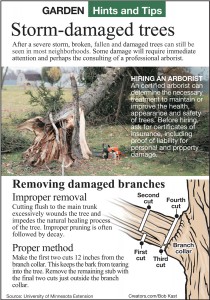By JEFF RUGG
Creators Syndicate
You may not have been in the path of one of the recent hurricanes, but you can still learn some tree planting and tree maintenance lessons from the areas that have been hit.
Wind damage from hurricanes is less frequent than thunderstorms; so potential tree problems go unnoticed for longer periods of time. When the winds finally do come, they have larger trees to destroy. The damage comes in two broad categories; trees either get broken apart or blown down.
More trunks, more risk
Trees with more than one trunk or that have rotting wood in a trunk are the most susceptible to wind damage. Once one trunk breaks, the rest of the tree is at greater risk.
Many trees planted in recent years have an upright growth pattern. They fit better in smaller yards and street areas, but they often have many vertical branches growing close to the trunk that offer no support for branches that lean outward. When the wind blows a branch outward, it snaps off and it often breaks off a whole trunk.
Whenever a multi-trunked tree’s trunks are so close together that the bark from one trunk is touching the bark of one or more of the other trunks there is a strong potential for a split tree during a storm. It doesn’t matter if the two trunks are touching at ground level or if they don’t start touching until they grow together 10 feet off the ground, this is a tree with a strong potential to break.
Also weakened
Trees that have been cut in half or have huge chunks missing because of power line pruning will have a strong potential for failure in high winds.
The top of a tree needs to stay balanced in shape to help it remain standing. Tall trees should not be planted under power lines. When the trees were there first, installing power linesunderground is better for the trees and the area is not susceptible to trees causing a power outage.
Little foresight
It is amazing how many large trees are planted in locations that can’t possibly sustain them for the long term. Most forest trees should not be planted in small un-irrigated parking lot islands, in concrete sidewalks with metal grates, in the five foot space between the curb and sidewalk and in the medians between streets.
The roots of a healthy strong forest tree grow several times farther than the branches. So, if the book says the tree grows to 50 feet across, the roots grow 150 to 200 feet across.
A 10-by-10 parking lot island will stunt the tree’s growth and the roots will not be able to support the top in a windstorm.
If a large tree has lots of space to grow roots in only one direction and the winds come from the other direction, there is a strong potential for the tree to blow over.
Large trees need large root systems balanced in size and shape with the top.
Get help
If you do have a tree with broken branches, either have it professionally pruned by a licensed arborist or learn how to do it properly yourself.
Never over-prune a damaged tree
During the next growing season it will need as many leaves as possible to produce enough food to heal its wounds.
Don’t waste your time keeping an old, heavily damaged tree when a new smaller properly planted tree would be better, but also don’t remove trees in fear of future windstorms.
During storms, many trees will lose a lot of small dead branches. If they leave subs larger than an inch in diameter, cut the stubs off so they don’t allow watering and fungi into the tree trunk. Trim the ragged edges around any branches that ripped the bark as they fell from the tree. This will allow the rip to heal faster.
Do not coat the wound with any black stuff or paint. Research shows that all of these coverings slow the healing process and protect decay organisms and insects, not the tree.
(Email questions to Jeff Rugg at info@greenerview.com. To find out more about Jeff Rugg, visit www.creators.com.)












